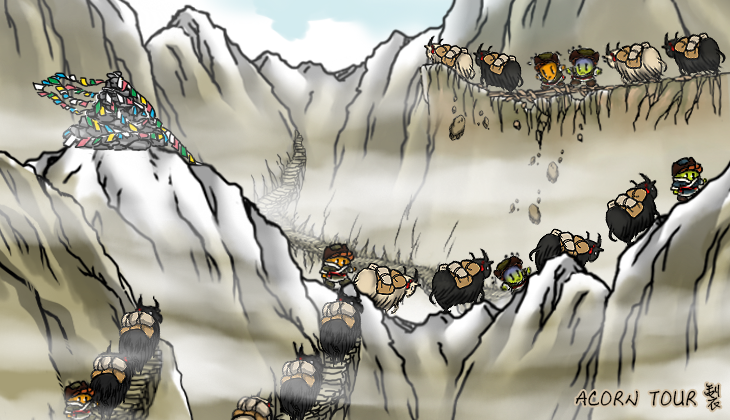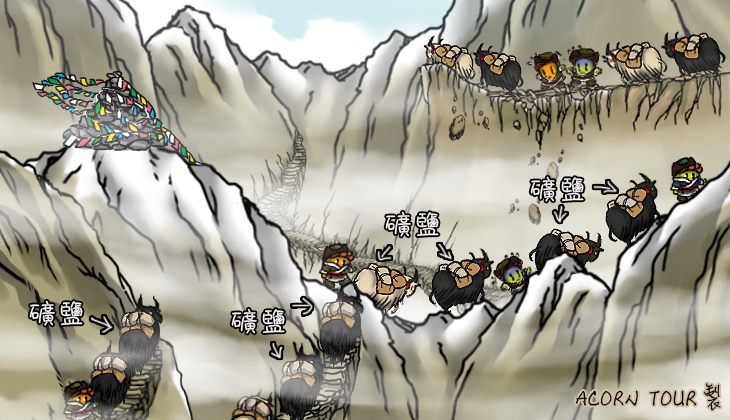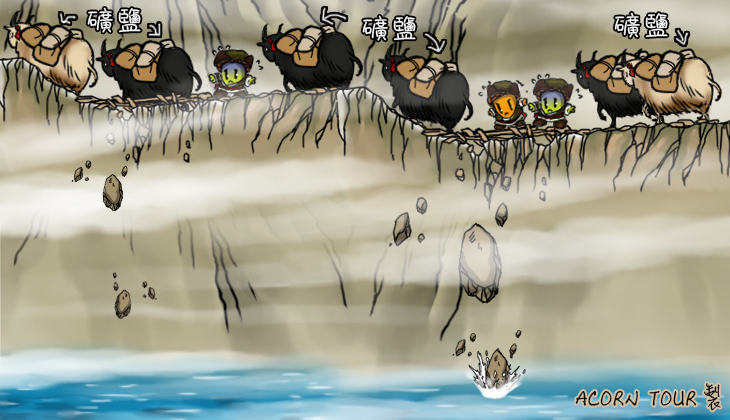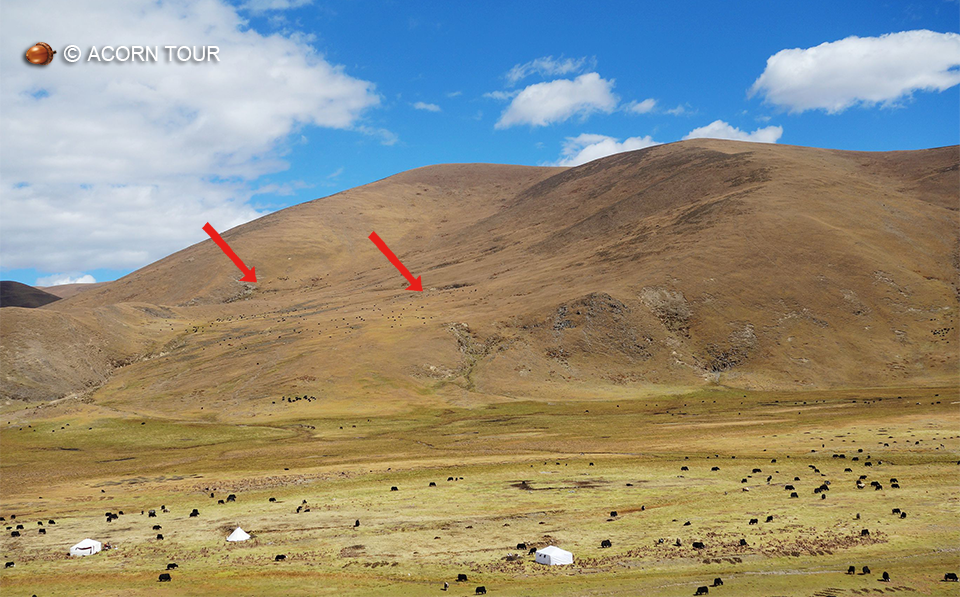
【Geography】The Borders - Chapter 5: Traveling for Survival
貧瘠的藏區高山為了生存,藏人用髦牛來馱運沉重的礦鹽,將礦鹽運到城市,換取全村所需的糧食。
In order to survive in the barren Tibetan areas, Tibetans use yaks to carry heavy mineral salt and bring the salt to the city to exchange for the food the village needs.
【小故事】為了生存的旅行
曾經有一部電影,故事內容就是在說明在大山中一個藏族小村落,村落的資源是匱乏的,沒有糧食跟物資,只有足夠給氂牛吃的芒草和鹽(礦鹽),所以村落的人需要辛苦地採集礦鹽,運輸上需要用氂牛馱運,翻越過好幾座山,山區路況與天候險峻,有時大風雪,有時前面是斷岩殘壁;然後將礦鹽運到大山以外的城市,以物易物換取糧食(小麥),才能讓整個村落生存下去。
【Little Story]】Travelling for Survival
There was once a movie about a small Tibetan village in the mountains where the resources of the village were scarce, no food and supplies. There was only enough grass and salt (mineral salt) for the yaks. People in the village needed to collect mineral salt, transporting it by yaks. To get to the city, the yaks and villagers had to cross several mountains, and the road was steep, the weather was sometimes very bad. For their survival, they had no choice but to take all the risks.

但是運鹽路程十分崎嶇險峻,除了村裡擁有豐富的經驗與大自然的知識的老頭目,還有對大自然崇敬和古老信仰才能達成任務。
The route of transporting salt was very rugged and steep. In addition to the experienced elderly who knew the natural environment very well, the villagers also needed to worship nature and the ancient belief in order to complete the mission.

故事中原本經驗豐富又崇敬自然的老頭目,和勇敢的年輕頭目,從衝突、不信任到互相幫助,老頭目將過去的經驗與信念傳承交接給年輕的頭目,一起完成了困難的生存旅行。
這是一趟艱辛旅程的故事。在困難的自然環境底下的人們,保有人類最純樸的願望,就是生存。
In the story, the experienced elderly and the brave youngster, went from conflict and distrust to mutual help. The elderly passed on his past experience and beliefs to the youngster, and they completed the difficult survival journey together.
This is the story of a difficult journey. People under the difficult natural environment have the simplest desire - survival.
【小常識 1】
鹽在古代有很重要的價值。鹽有四種,海鹽,井鹽,礦鹽,湖鹽。
海鹽在沿海島嶼國家取得容易,只要曬乾就可以取得。
井鹽主要在靠海的陸地國家,需要開井,並用柴燒取得。
礦鹽最為珍貴,因為有的在山區,有的在地底下,開採取得不易。
湖鹽是從鹽湖中直接采出的鹽和以鹽湖滷水為原料在鹽田中曬制而成的鹽。
所以在藏區的運輸上,氂牛佔很重要的角色。山區的藏人用氂牛來馱運沉重的礦鹽,將礦鹽運到城市,換取生活所需物品跟糧食。
【小常識 2】原來牛喜歡品嚐鹽的味道
氂牛需要馱運沉重的鹽礦,藏人為了獎勵氂牛,馱運的路程中會手拿礦鹽,讓氂牛舔一下礦鹽,在勞累時驅使牠往前,這方法是友善的對待,並不是用鞭打方式,說明了藏人和氂牛友善相處,有點像驢子愛吃紅蘿蔔狀況,為了讓驢子繼續前進,就在驢子前面掛了一根胡蘿蔔,驢子為了要吃掉眼前的胡蘿蔔,就會往前走。
一般畜養牛的時候會讓牛舔一點鹽巴補充養分。
在非洲草原部落,會在水池邊灑鹽巴,然後就可以看到非洲野生水牛被吸引過來,在不破壞生態平衡的情形下,又可以看到。
【行程】
![]() [非洲自然生態之旅]
[非洲自然生態之旅]
【小常識 3】
氂牛在藏人的心目中是非常重要的。
氂牛毛可以做為禦寒的衣物;
氂牛奶可以做為提供熱量的酥油茶;
氂牛肉可以做為提供食物的來源;
氂牛糞可以做為取暖與烹煮的燃料;
氂牛角可以做為梳子;
氂牛骨可以做為護身符。
【小常識 4】
氂牛的腳很像穿高跟鞋一樣,卻可以爬陡峭的山坡和山壁。我們在大草原上的帳篷附近看到髦牛為什麼都不是很大隻,難道這裡品種是比較嬌小嗎?詢問一下游牧的藏人,明白了藏人會把體型較大、體力較好的公氂牛趕到比較遠的郊區和陡峭山區上吃草,而母氂牛和幼仔,就會在遊牧民族的帳篷附近平緩的草原上覓食。所以帳篷附近看到的氂牛,都是體型比較小的母氂牛或小氂牛。最後氂牛們自己吃飽會認路回家。
【Knowledge 1】
Salt was invaluable in ancient times. There are three kinds of salt: sea salt, well salt, and mineral salt.
Sea salt is easy to obtain in coastal island countries and can be obtained as long as it is dried.
Well salt is mainly found in land countries that are close to the sea. It needs to be found form wells and dried with firewood.
Mineral salt is the most precious because it can only be found in mountains and underground, and it is not easy to mine.
Therefore, yaks play a very important role in transportation in Tibetan areas. Tibetans in mountainous areas use yak to carry heavy mineral salt and transport it to cities in exchange for daily necessities and food.
【Knowledge 2】 Yaks Like the Taste of Salt
Yaks need to carry heavy salt mines. In order to reward the yaks, Tibetans carry mineral salt in their hands during the journey, let the yak lick the salt, and drive it forward when tired. This is way much friendlier compared to whipping them. It also shows that Tibetans and yaks have positive relationships. It’s a bit like donkeys love to eat carrots, so in order to keep the donkey going, people hung a carrot in front of the donkey. The donkey will move forward because it wants to eat the carrot in front of him.
Generally, it will let the cattle lick some salts for a nutritional supplement when raising cattle.
In the tribes in the African grassland, people sprinkle salt on the side of the water pool, and then you can see the African wild buffalo being attracted. In this way, people can appreciate the buffalos without damaging the ecological balance.
【Tour Item】
【Knowledge 3】
Yak is very important to Tibetans.
Yak fur can be used to make warm clothing.
Yak milk can be added in butter tea that provides calories.
Yak meat can be used as a source of food.
Yak dung can be used as fuel for heating and cooking.
Yak horns can be made into combs.
Yak bones can be amulets.
【Knowledge 4】
The feet of the yak are like wearing high heels, but they can climb steep slopes. We saw yaks near the tent were not very big. Was the breed there relatively petite? We asked a local Tibetan there and he told us that Tibetans would drive larger and stronger male yaks to graze in remote suburbs and steep mountains, while female yaks and baby yaks would stay near where the people live and graze on flat grassland. That was why the yaks seen near the tent were all female yaks or baby yaks with smaller size. In the end, the yaks would recognize their way home after grazing.

上圖比較大的黑點是體型比較小隻的母氂牛和幼仔,山上比較小的黑點是體型比較大的公氂牛。
The larger black spots in the picture above are the smaller female yaks and baby yaks, and the smaller black spots on the mountain are the larger male yaks.
【小常識 5】
藏地有一些柵欄圍起來的草地,為什麼裡面沒有氂牛?
因為這些圈起來的草地,是藏人們為了替氂牛們保留冬季食用的牧草,因為氂牛吃草很隨興,不受管制的話,平地的草原很快就會東禿一塊、西缺一塊,到冬季牧草就不夠吃了,所以每個被圍起來草地都有精算過,平常不會放氂牛群進來。
【Knowledge 5】
There are some grasslands enclosed with fences in Tibet. Why are there no yaks inside?
Because these enclosed grasslands are used by Tibetans to reserve forage for the yaks in winter. If they don’t do so, the yaks will eat up all the forage, and there won’t be enough grass to eat in winter. So every fenced grass has been carefully planned, and yaks are not allowed to be in.
.jpg)
PS-1:就是這一隻頑皮的小氂牛,趁人打開柵欄時,偷偷闖進柵欄裡,想飽餐一頓,最後被草地主人發現,追著小氂牛跑,最後才將牠趕出去。
PS-2:就是這樣像穿著高跟鞋的腳型,氂牛可以爬越陡峭的山坡和山壁。
p.s.1: It was this naughty little yak sneaking into the fence and trying to have a big meal when someone opened the fence. He was found and chased by the owner, then finally driven out of the fence.
p.s. 2: Like wearing high heels, yaks can climb steep slopes and mountains.
【小常識 6】犏牛
在低海拔的藏地,可以看到有點像氂牛但有點醜、毛又參差不齊的牛,這是為了適應低海拔的氂牛與黃牛的混血兒,叫做「犏牛」。
犏牛分為犏牛(公)和犏乳牛(母)。犏牛具有雜交的優勢,在肉與牛乳的生產能力、以及勞役能力接近氂牛。
產乳量一天約3.5~5.5公斤,飼料充足時,可提高約2~7公斤,但品質比氂牛差。犏牛在一定條件下,產肉量比氂牛要高,但肉質也比氂牛差。
【Knowledge 6】
In low-altitude Tibetan areas, you can see cattle that look like yaks but are a bit ugly and with uneven fur. They are yak-cattle hybrids. This species can adapt to the low-altitude environment.
Yak-cattle hybrid inherits the advantages of cattle and yak. Their meat and milk production capacity and labor capacity are close to yak’s.
The milk production is about 3.5~5.5 kg per day. When they are fed sufficiently, it can increase by about 2-7 kg, but the quality is worse than that of the yak. Under certain conditions, the meat yield of yak-cattle hybrid is higher than that of Yak, but its meat quality is also worse than Yak.

【行程】
![]() [藏地之旅]
[藏地之旅]
![]() [蒙古之旅]
[蒙古之旅]
【Tour Item】
【待續 to be continue …】
10/13/2017
【著作權聲明】
本站所刊載之所有內容,除著作權法規定不得為著作權之標的(如法律、命令、公務員撰擬之講稿、新聞稿等...請參考著作權法第9條規定)外,其他包括文字敘述、攝影、圖片、錄音、影像及其他資訊,均受著作權法保護。任何人未經原作者同意不得盜用、複製、轉錄、散佈部分或全部內容。
【Copyright Notice】
All content published on this site that except the items shall not be the subject matter of Copyright Act that such as laws, orders, text of speeches, news releases and etc., please refer to the Article 9 provisions of Copyright Act the others all protected by Copyright Act including textual narratives, photography, pictures, sound recordings, images, and other information. No one may misappropriate, reproduce, transcribe, or distribute part or all of the content without the consent of the original author.


